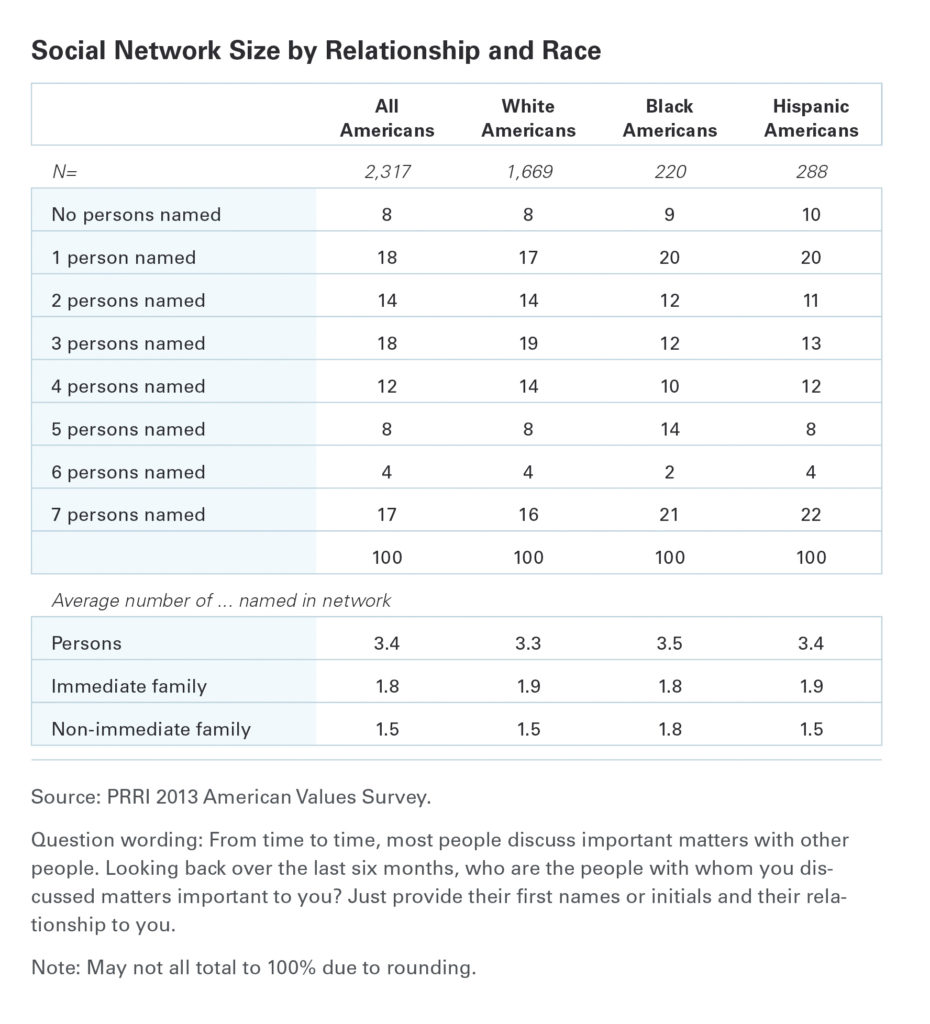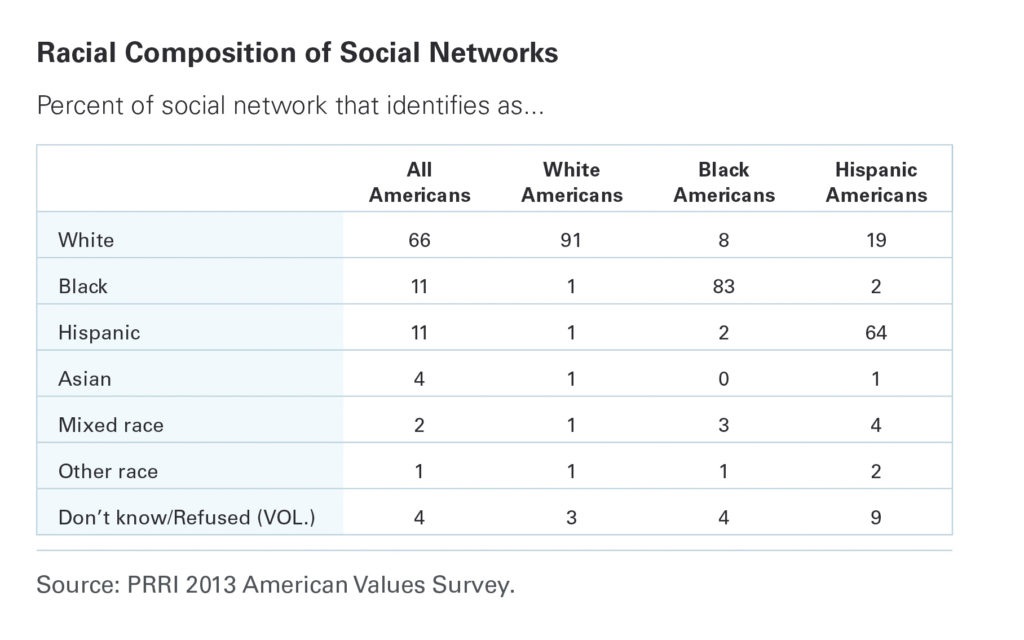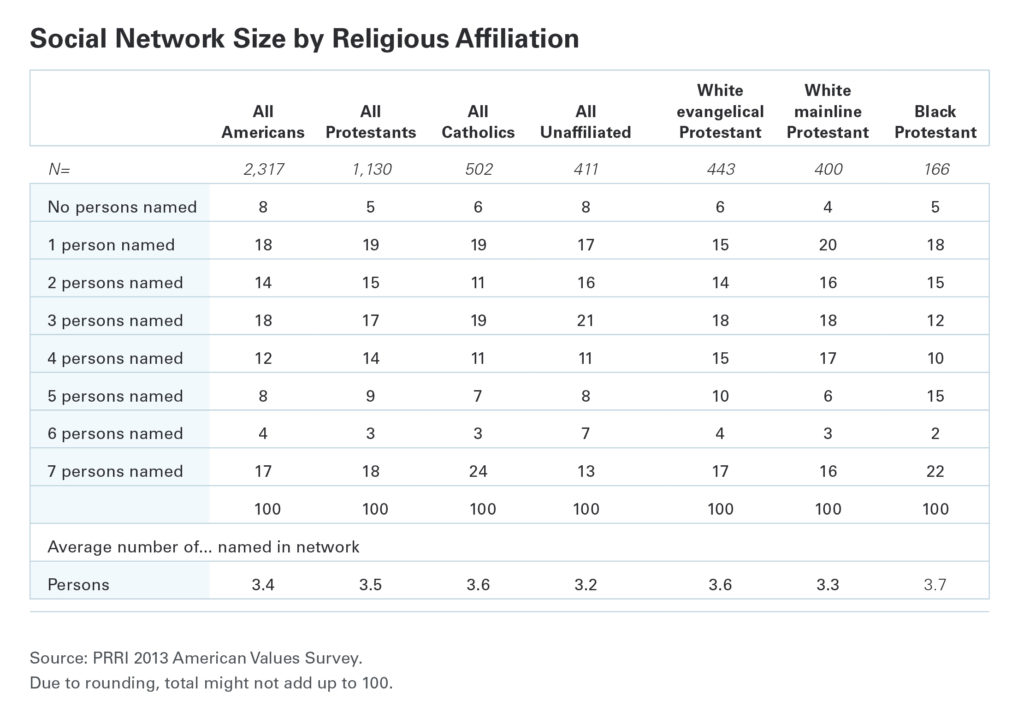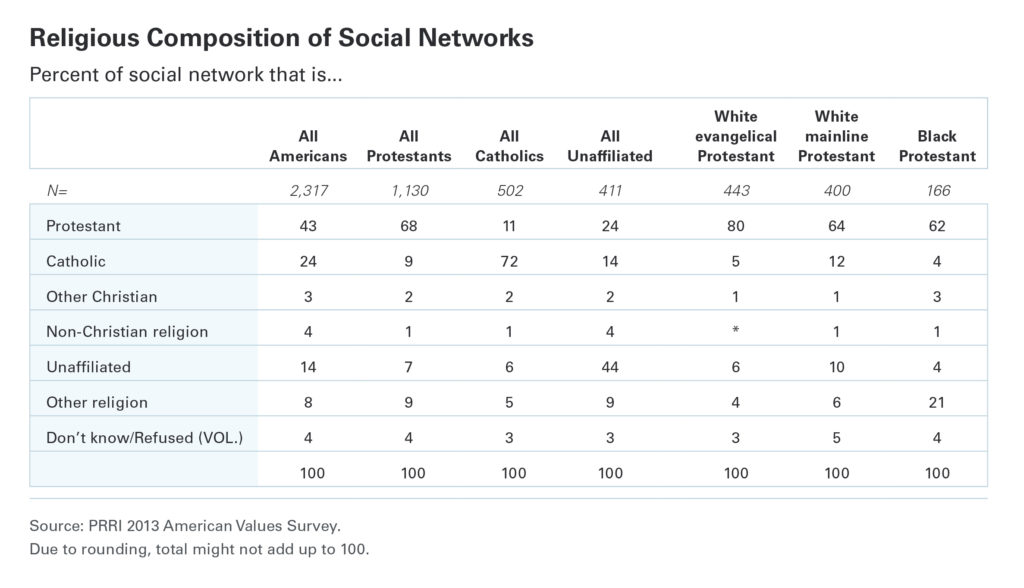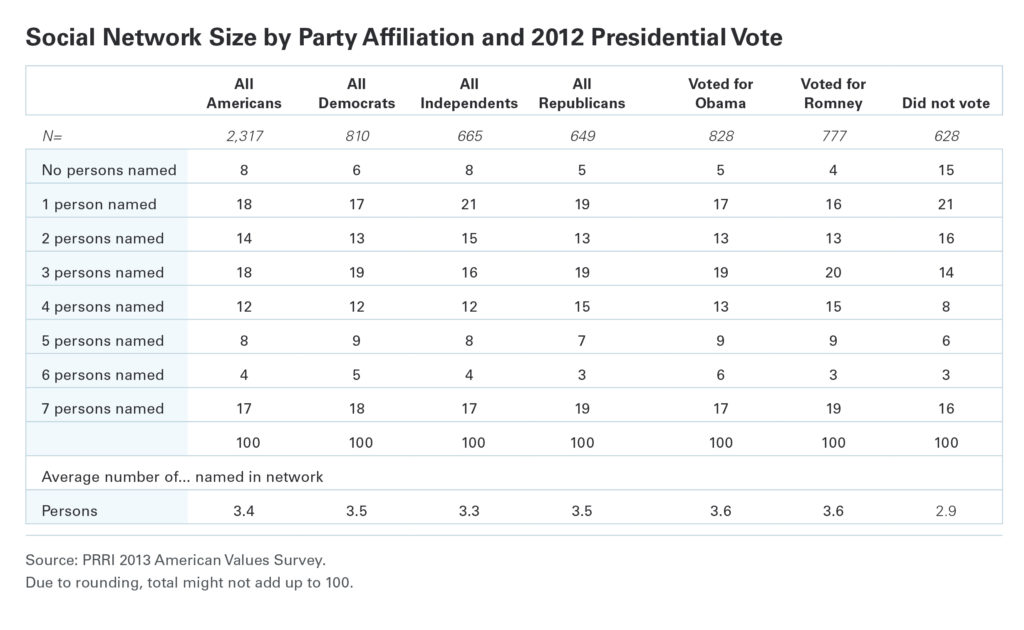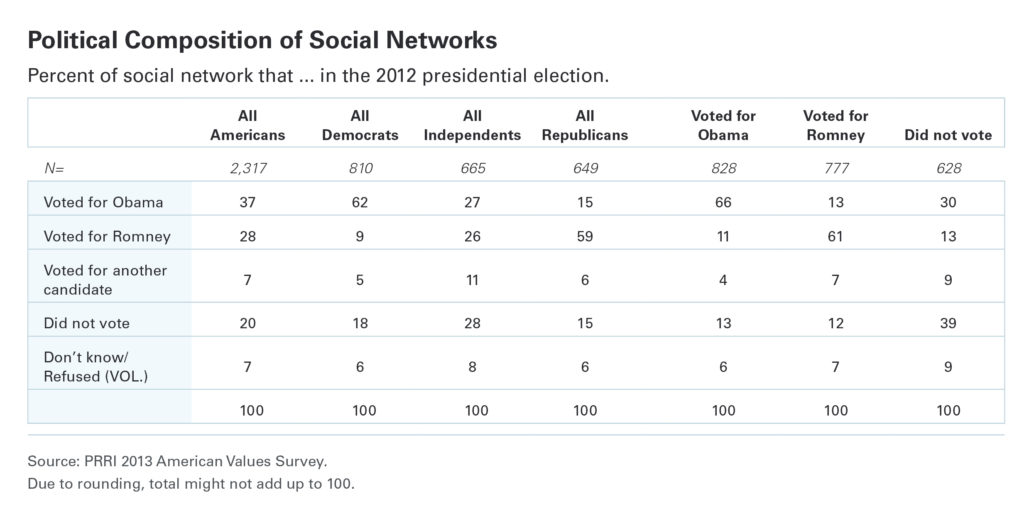Few opinions are formed and few experiences occur in isolation. Rather, Americans’ social environments—including siblings, spouses, parents, or close friends—play a critical role in shaping how they view and understand the world around them. These social networks can vary considerably, including by racial and ethnic background, political leanings, and religious identity of individual members.
To better understand the composition of the public’s social networks, PRRI conducted a study as part of its 2013 American Values Survey (AVS) designed to assess the scope and diversity of Americans’ social networks. This approach—known in the social scientific literature as “egocentric network analysis”—is designed to measure the ways in which individuals’ choices and attitudes are influenced by their family and close friends. The method of measuring Americans’ core social networks was modeled after the General Social Survey; respondents were asked to name people with whom they “discussed important matters” in the previous six months regardless of the nature of the relationship or the frequency of interaction.
I. Social Network Size and Distribution
There are only modest differences in the distribution and average size of Americans’ core social networks. Among the public overall, only eight percent of Americans name no persons in their social network, 50% name one to three persons, and 43% name four or more persons.
Americans overall reported, on average, a social network of 3.4 people out of a maximum of seven people. Overall, people named in these networks are slightly more likely to be immediate family members (an average of 1.8 people) than non-immediate family members (an average of 1.5 people).
II. Racial Composition of Social Networks
Americans’ core social networks tend to be dominated by people of the same race or ethnic background. However, the degree of racial and ethnic diversity in Americans’ social networks varies somewhat according to their particular race or ethnicity. Among white Americans, 91% of people comprising their social networks are also white, while five percent are identified as some other race. Among black Americans, 83% of people in their social networks are composed of people who are also black, while eight percent are white and six percent are some other race. Among Hispanic Americans, approximately two-thirds (64%) of the people who comprise their core social networks are also Hispanic, while nearly 1-in-5 (19%) are white and nine percent are some other race.
III. Racial Homogeneity of Social Networks
The homogeneity of a particular core social network—that is, the percentage of Americans with social networks that are entirely comprised of people from the same racial or ethnic background—also varied according to race and ethnicity. Fully three-quarters (75%) of white Americans report that the network of people with whom they discuss important matters is entirely white, with no minority presence, while 15% report having a more racially mixed social network. Approximately two-thirds (65%) of black Americans report having a core social network that is composed entirely of people who are also black, while nearly one-quarter (23%) say their network includes a mix of people from other racial and ethnic backgrounds. Less than half (46%) of Hispanics report that their social network includes only other people who also identify as Hispanic, while more than one-third (34%) report having a mixed social network. Notably, nearly one-in-ten (9%) Hispanics report having an all-white core social network.
IV. Racial Homogeneity of Whites’ Social Networks
There is little variation among white American subgroups in terms of the racial homogeneity of their core social networks. White Republicans (81%) are about as likely as white Democrats (78%) to have social networks that are entirely composed of whites. Among white independents, 73% have social networks that are comprised entirely of people who are white. More than eight in ten (82%) white Midwesterners report that their core social networks are entirely composed of whites, compared to more than three-quarters of white Northeasterners (78%) and Southerners (77%), and 68% of white Westerners. White seniors (ages 65 and older) are only slightly more likely than white young adults (ages 18-29) to have entirely white social networks (80% vs. 72%, respectively). There are, however, no substantial differences by gender: men (76%) are about equally as likely as women (77%) to report having all-white social networks.
V. Religious Social Networks
Americans’ core social networks not only demonstrate substantial homogeneity by race and ethnicity, but Americans are also much more likely to associate with people who share their religious background. For example, 72% of the people that make up the social networks of Catholics are other Catholics, and 68% of individuals in Protestants’ social network also identify as Protestant.
The core social networks of different Protestant denominations vary somewhat in terms of their religious diversity, however. White evangelical Protestants have more religiously homogeneous networks than white mainline or black Protestants. Fully 80% of the people who make up the social networks of white evangelical Protestants also identify as Protestant. In contrast, more than six in ten social connections of white mainline Protestants (64%) and black Protestants (62%) are Protestant. The religiously unaffiliated are far less likely to have social networks that are primarily made up of people who share their religious identity. At the same time, they are far more likely to have connections who are also unaffiliated than Americans overall. Forty-four percent of the core social connections reported by unaffiliated Americans are also unaffiliated. Protestants make up roughly one-quarter (24%) of unaffiliated social networks, while Catholics account for 14% of the people in their network.
VI. Political Networks
Americans also tend to sort themselves by political affiliation. Democrats are much more likely to count members of their network who were Obama supporters, while Republican core social networks are made up of a disproportionate number of Romney supporters. Among people in Democrats’ social network, more than six in ten (62%) voted for Obama in 2012, while only about one in ten (9%) supported Romney in the 2012 election and roughly one in five (18%) did not vote all. The networks of Republicans include a disproportionate number of fellow partisans. Among people in Republicans’ social network, about six in ten (59%) voted for Romney, while only 15% supported Obama and an identical number (15%) did not vote in the 2012 election. Notably, the networks of political independents are much more diverse. Independents report having members of their network who are about as likely to have voted for Obama (27%) as Romney (26%). A startling 28% of the people who are part of the core social networks of independents sat out the 2012 election.
The pattern among Obama and Romney voters is quite similar. Roughly two out of every three (66%) people who comprise the social networks of Obama voters also supported the president’s reelection. The networks of Romney voters also included a disproportionate number (61%) of those who supported the GOP candidate. Notably, roughly four in ten (39%) people that comprise the core social networks of nonvoters also did not participate in the 2012 election.
Methodology
The method of measuring Americans’ core social networks was modeled after the General Social Survey; respondents were asked to name people with whom they “discussed important matters” in the previous six months regardless of the nature of the relationship or the frequency of interaction. The first step in this approach, often referred to as “the name generator,” is to have respondents record the names of all the people in their network. Next, respondents are asked to provide relevant social and demographic information for each member of their network they previously identified. Once, respondents recorded the names or initials of each social connection, they moved to a new screen that asked them to “describe a few characteristics of the people with whom you discuss important matters.” Five distinct identifying characteristics were provided about each social connection: relationship to the respondent (e.g. parent, spouse, friend), gender, race, religious identity, and 2012 presidential vote preference. In order to maximize efficiency, respondents were able to select options from a pull-down menu. The names or initials of each social connection that were initially recorded by the respondent appeared at the far left side of the screen in the same row as the characteristics in an effort to minimize the cognitive effort for respondents and reduce the possibility of error.
The current study design differs from the GSS social network battery in a couple important respects. First, the survey was self-administered online providing a more efficient and cost effective way to collect the social network data. Second, this method differs from the GSS in allowing each respondent to identify up to seven possible social connections, instead of a maximum of five that was allowed in the GSS.
The 2013 American Values Survey covered a range of other topics, including analysis of libertarians in American politics. For additional findings from the 2013 American Values Survey, click here.
* Note that the PRRI survey design differs from the General Social Survey (GSS) in several ways. First, the survey was self-administered online. Second, the PRRI design allows respondents to name up to seven people comprising their social network instead of the GSS’s limit of five people.
